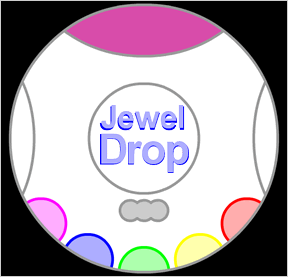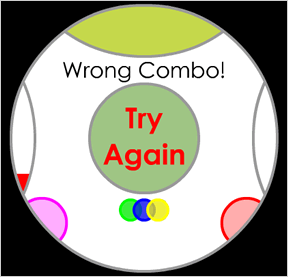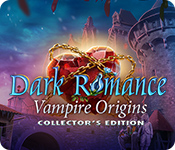Jewel Drop
 Another competition entry that was only narrowly edged out of an award, Jewel Drop by Nick Redmond of Iowa, USA, consistently received high marks from each of the four reviewers.
Another competition entry that was only narrowly edged out of an award, Jewel Drop by Nick Redmond of Iowa, USA, consistently received high marks from each of the four reviewers.
This ear-training, color-layering game features a clean and appealing interface and a luxuriously rich soundtrack that together create a unique and original game play experience.
The objective of the multi-level puzzle game is to identify the three (3) colors and notes that make up the composite sample given at the top of the circular game window. The sample is made up of three (3) different colors layered one on top of another, and three (3) different notes played simultaneously. Just mouse over the sample to hear the resulting musical chord.
There are five (5) colored disc-shaped "jewels" from which to choose, with each one containing a different color and a different musical note. Simply mouse over each disc to hear its note.
Once you have identified the constituent notes/colors, you must next decide their order. Remember that you are layering colors on top of one another and not mixing colors as with liquids. The last jewel on top will be the dominant color of the trio.
Drag and drop your choices, one-by-one, onto the center circle. Guess the sample within the number of tries indicated to advance to the next level.
Analysis: Before I say any more, I really want to say that I love this game. It is elegantly simple, unique, and creative. The ear-training component is an area that I have longed to see explored in a game since the Music Theory courses I took at RIT. I love the sound samples Nick has integrated into the gameplay, as well as the smooth and seamless layering that occurs when playing multiple sounds in succession. Being able to choose between guitar and piano is frothy icing on this already richest of cakes. On the surface it's an amalgamation of sensory stimuli bordering on the self-indulgent; decadent.
However, dig a little deeper to discover the game contains a great idea with a slightly flawed execution. On the one hand, the player is given a single chord made up of three notes that must be identified where order does not matter. And on the other, the player is given a single color combination made up of three unique colors that must be identified, and yet order does matter.
 While the player will likely grasp the concept quickly of identifying the three notes of a chord and even the three colors of a color swatch, many will likely be confused when they discover that layering three colors in different orders produces different results. This is because there are many more examples familiar to us in which color mixing is not dependent on order. For example: mixing RGB light of a computer monitor (additive color), and mixing dyes in ink or paint (subtractive color). I am not learned in color theory, but my intuition tells me that neither are most casual gamers.
While the player will likely grasp the concept quickly of identifying the three notes of a chord and even the three colors of a color swatch, many will likely be confused when they discover that layering three colors in different orders produces different results. This is because there are many more examples familiar to us in which color mixing is not dependent on order. For example: mixing RGB light of a computer monitor (additive color), and mixing dyes in ink or paint (subtractive color). I am not learned in color theory, but my intuition tells me that neither are most casual gamers.
From the usability heuristics of Jakob Nielsen we know that a human-computer interface should provide a match between the system and the real world, using words and concepts familiar to the user and following real-world conventions. Requiring the player to think in layered colors, which I believe will be a foreign concept to most, is where this game breaks down.
The result will likely be a methodical approach by many players to guessing the correct order of the target color, which doesn't turn out to be much fun once this is realized.
The other and more obvious problem, of course, is the game's accessibility issues: it is simply not playable by anyone deaf, hard-of-hearing, or with any form of color-blindness.
While it's easy to sit here nitpicking it apart, it's not so easy to come up with ways of addressing these issues. Accessibility issues aside, I believe there is an exceptional game design here if the usability issues are addressed first and foremost. Otherwise, it's just a great game idea with significantly unrealized potential.
![]() John: Jewel Drop requires something most of our other competition entries don't: a good ear and a sharp sense of color. It's unusual in that it tricks your brain into fighting itself for dominance: the left side tries to solve the puzzle while the right side digests the color and sound. I won't pretend I didn't have a tough time with this game at first, but finally I got the hang of it. Jewel Drop is a great game to crank up the speakers and relax with at the end of the day. It's also perfect for playing with more than one person at the computer. It's a little light on the "puzzle" aspects as compared to our other entries, but what it lacks in logical challenge it more than makes up for in elegance and beauty. A fantastic creative accomplishment by Nick Redmond!
John: Jewel Drop requires something most of our other competition entries don't: a good ear and a sharp sense of color. It's unusual in that it tricks your brain into fighting itself for dominance: the left side tries to solve the puzzle while the right side digests the color and sound. I won't pretend I didn't have a tough time with this game at first, but finally I got the hang of it. Jewel Drop is a great game to crank up the speakers and relax with at the end of the day. It's also perfect for playing with more than one person at the computer. It's a little light on the "puzzle" aspects as compared to our other entries, but what it lacks in logical challenge it more than makes up for in elegance and beauty. A fantastic creative accomplishment by Nick Redmond!




this game was interesting to say the least. I am not a music person so I couldn't really finish even the first lvl, but that doesn't matter, as I enjoyed trying to figure it out. The background music is calming and not in-the-way and the very idea for this game is charming.
Loved it and wouldn't mind seeing a bigger version with more instruments.
While I like the game, the addition of the order to the coloring makes it basically unplayable, IMO. Naturally, when I tried the game, I had not read your review. After a bit of trial and error and a few false starts, I was able to get past the first level, but failed on the second level. Since I could clearly hear that the notes matched, my assumption was that the game was broken and so, frustrated, I gave up on it. Only after actually reading the review of it did I learn that order was important for the color, and now knowing that, I might be better at it, but frankly I'm no longer interested.
Interesting idea, good execution, but the ordering aspect is too complex for an instructionless flash game. Remove that part and you'd have a winner.
Thanks for the feedback, Otto.
An important point worth noting here is that the first competition entry submitted from Nick included several screens of instructions prior to the start of the game. Even after reading them in which it stated that order mattered, I was still as confused as you were when it came to actually playing the game.
I suggested to Nick that he remove the instructions and instead provide visual feedback that the colors were being layered on top of one another. That is when the 3 smaller circles were implemented.
I maintain that the layered color concept is just too foreign to the average player to make for successful gameplay.
Someone please prove me wrong because I want to love everything about this game.
Woh.. I was just writing a "what the heck" comment, when it finally clicked.
Having a significant theory background, though not the best ear, I was thinking I was supposed to be arranging the colors in the most logical ordering of the chord, root up. A G major triad as GBD, etc. I think it was the mention of "dominant" color on top that threw me. I think I see now that we are hunting for a color match, which makes it worth going back and giving this game a second try.
Well, that made the game much simpler, though still somewhat of a trouble as there appear to be two seperate shades of purple that are showing identically on my screen.
I notice that you can drag the colors around on the screen onto each other prior to inserting them in the middle. But is seems you can't toggle them from top to bottom to try out color combos. Perhaps doing so might make the game too easy, but it could be a benificial option. Really, with an up or down function prior to insertion to explore the resulting shades, perhaps a bit more room to encourage users to do so without having to tell them, and this could easily be a brilliant, no instructions needed game, IMO. But still quite enjoyable as is. (An additional fun item could be to design the layout in the shape of a painters pallet. Could help with the mental connection of color mixing)
Ok, I'm going to go now. I get all excited about music and art. My final conclusion is; I love the idea of this game!
Good idea, bad execution. There are two major frustrations with this game: First, it says "Wrong combo!" even if you clearly have the right combo. It should at least say "Wrong order!". Second, once you figure out that you need the colors in a specific order, there's no way to switch them around in order (ha!) to try it out before you drop them in the middle. But I guess that would remove the chance/guessing element of the game make the "six tries per round" pointless.
Basically it feels like the whole concept is fundamentally flawed. I'm sure there are lots of fun games that could be made around recognition of sounds and colors (accessibility issues aside -- but if we had to sympathize with the deaf and blind all the time there would be little of interest left in the world...), but I'd encourage Nick Redmond to kill this baby and explore the concepts further along other paths.
Thanks for the reviews as well as the comments! The game certainly takes a good ear as well as an eye. A bit of advice on trying to figure out the correct color combination:
First figure out what the LAST color should be. It will be the most dominant. Then decide which color of the other two looks to be stronger.
For example, if the three colors you figure out from the sound are Red, Green, and Pink, and the top color is reddish, then Red is probably the last color you should put in. Then ask yourself, "is it more of a green-red, or a pink-red?" If green-red, the green should be second, or else vice versa.
I find I can easily get over 10,000 points doing this (although the red and blue levels are tricky since there isn't as much distinction between the different colors).
Nick, accept the feedback :)
I too really love the sound recognition and chord idea, and think its nicely done.
However that the order matters on vision and not on sound is something I really hated the game for, and gave up after level 2.
Before reading the comments I never had thought of letting the order matter by colors, and playing I just thought, Stupid game that IS exactly the cord it played, why the heck does it say "wrong combo" :)
I think that all you guys who don't like this game are just annoyed because you can't get very far. Coming from a very musical background i had no problems in playing. I would like to see more instuments and higher difficulty levels though.
I played this game first time round when it was in the competition and did not get it in the slightest. After realising you have to DRAG the colour circles...all fits into place!
I really enjoyed this, it really helped me in a musical sense Ive never been able to differentiate between notes in a chord so thanks for that :)
My main hang-up were the close-colour rounds: especially in the blue round I fail to see how it is possible to pick a certain colour of turquoise from 3 shades of...well...turquoise! These I got through purely by chance so when it got to 2 tries I lost quite quickly!
Other than that its a great game, Id also like to see some harder levels - perhaps instead of narrowing down the colour spectrum you could add more notes to the chord and more notes to pick from? For example, picking a 5-note chord from 10 notes might step it up a bit :)
overall good game, loved playing it
I was initially very fascinated by the chord combos. I have no training in music or art, but I got the basic hang of things after failing the first few tries. (Still, I never got past the 2nd level.)
My biggest suggestion for improving the game has got to be the option of layering the colors. There were a couple of times when I realized I was on the wrong track with my first color but couldn't remove it from the center. Being able to mix and match the jewels before committing to them would have really helped.
I love the idea for this game — and I think the ordered color works, except that it isn't intuitive and there isn't adequate feedback. In many cases, several different orders of the correct colors look almost exactly the same, so it can be hard to even see that there isn't a match.
I think this could be a general guideline in puzzle games: When an attempted solution succeeds, it should be clear why. When an attempted solution fails, it should either be clear why or it should not cost the player anything — otherwise the player isn't learning anything in return for their risk.
Whatever non-commutative (order matters) color-mixing algotrithm is being used, it's one in which it's possible for two different orders of the same colors to give the exact same RBG result. Is it testing for success based on the actual resulting color, or do you have to guess the same order? I think that, in cases where a different order gives the "same color" to within some fairly tight threshold, that should count as correct — that would relieve a lot of my anxiety about this game.
Oh, another thing — having it show which combinations you've already tried would be a big help.
Ben - very nicely worded. I agree completely. Excellent feedback. =)
I like the concept of the game. I find it to be laid back and relaxing, though I wish there were an easier way of testing your chosen chord vs the sample chord other than grouping the circles together and rapidly racing your mouse across them.
I personally would rather give up the six chances and have more tools to test my colors and chord vs the sample chord so that I don't have to sit there and try to remember which shades I had finally decided on in the last attempt.
My problem with the game is that it quickly becomes repetitive. I enjoy the challenge up to a point, but once you figure it out, there's no real variety. The sounds are fairly easy to match, but the color comes down to trial and error since, unlike the sound, it is not possible to get a sense of how the colors will combine before their selection. One useful tip is to keep a list of the combinations tried--usually the dominant color is easy to pick out, but in the case where the colors get very close to each other, it's mainly luck.
My suggestion for modifying the game would be to either remove the order component, or break the chord slightly so that one can hear the order, and so there's consistency between the visual and aural feedback. In either case, this makes the game easier, but to compensate, you might have multiple instruments, or more than 5 choices, or more than 3 selections. You might implement a timer as well, or perhaps twist it around and select the sounds or colors that do NOT appear in the sample. There are many possible variations.
You get six tries for each chord. I just noticed that's the total number of sequences of 3 colors. So trial and error, although tedious, will always allow you to complete the level.
Well, not always, Jim. In later levels the number of tries you're allowed is reduced to increase the difficulty.
There is one trick that I discovered, although it could be my mind playing tricks on me.
Just as the last color becomes the most dominant, so does that note become the most dominant in the chord. This worked for me to get with one try the first 4 levels correct in a row and it kept me correct within 2 tries from then on.
That's just an alternate way for those better with their ears than with their eyes.
When I first played this game I couldn't understand why it wouldn't accept my combination, when the chord sounded the same: I didn't realise that order affected colour mixing (as Jay says in his original view, I'm guessing most people are the same).
However, since I've realised this, it's added a new difficulty to the game that makes it more playable for me, since I have a fairly musical ear.
I agree with the point Ben made about perhaps showing colour orders you've already tried which could not only help you avoid trying the same order twice, but could help you asses what you need to do in order to achieve the correct sequence.
As I just said, before I played this game I had no idea that order made a difference in colour mixing, but now I do. And I think this game has helped me understand it a little bit too.
The highest score I've achieved so far is 4000 and I'm continuing to try and beat it.
This is a great concept and I'd like to see it developed further.
Now that I know it's a
drag&drop
interface, I can finally play this game. I was clicking like a monkey on a cupcake in frustration before this page explained how to play. I love musical puzzles.
I found the colour layering fine but I do come from a design backfground. I agree that it is easier to guess the notes first and the hardest bit was the order of the colours
Every level gives you 6 tries, and use permutations, the arrangement of 3 items is 3! = 6. So if you figure out the correct chord, you can win the round even if you can't figure out the order of the colours.
Except when the number of tries is reduced in later levels. ;)
What you should do is to first pick out the colours of the chord, and then decide on the least dominant colour, which is in fact easier than picking out the dominant ones.
Very very nice game... I loved the combination of colrs and sounds and the game was just as complicated as it should be. My favorite entry to the competition.
Ok, so here's what I've found. Here's a screen shot of a Wrong Combination:
http://discodan.org/gfx/colormatch01.gif
Before converting it to .gif I used a paint program and the eye-dropper tool to get the colors used in each circle. At first glance, and even upon closer inspection the two seem to be the same color. Below are the values contained in the two circles in RGB format. There is more than one value per area because of the jpg compression in the game.
Upper (original):
247 170 123
247 170 115
239 162 115
239 166 115
Lower (my wrong combo):
247 166 115
247 162 115
255 166 123
As you can see, the average total difference in the colors is 14. The largest difference in any one hue in a color is 16, with the smallest being 4 (not including 0).
I'm at work and it's slow this week, so that's what I had time to do. Anyway, I've found, as far as strategies for the game go, that if you keep at it, and pay attention to what the colors do when their mixed in different orders, you start to get an idea of how they react and can start to predict the outcome to within one or two tries. At least, that's how I've found it. The chord part, for someone with a musical ear, is almost TOO easy, but after a while, the color part becomes easy enough to keep trying, but hard enough to still present a challenge.
Also, it should be noted that the correct order to the above level was yellow-orange, light-green, magenta.
Notice that the incorrect combination results in a color that is just ever-so-slightly more red than the correct solution. Noting that the prominence of the colors is in reverse order, we can see that by switching the order of the yellow-orange and light-green colors, the yellow-orange would be less prominent, thus reducing the slight over-abundance of the red hue.
By that methodology, one SHOULD be able to find the correct solution to any given color.
SHOULD.
As a guitar player, I play this more for practicing my note recognition then for the actual game. Although like everyone else, I hate losing, so the color order idea got me a little frustrated in the later levels.
As for increasing difficulty, I agree with elv and atomic about adding more notes to choose from and more notes in a chord instead of making more similar colors.
when i had first played the game when it came out i was incredibly frustrated. hating the layering of colors mainly. after replaying it though i have founf it alot more simple and just figure out which combination it is and then see which is dominant and after that its only two possibilities.
Being a musician and a graphic designer, I loved this game. I still found it quite challenging, though, and my top score so far is 3900, so I can imagine that for people with neither musical nor visual backgrounds it would be infuriating.
Kudos for doing something really different!
Update